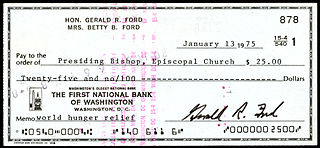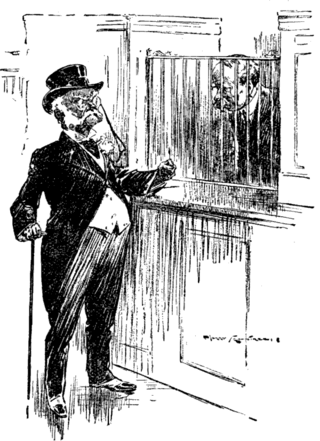Related Research Articles
In the United States, the ACH Network is the national automated clearing house (ACH) for electronic funds transfers established in the 1960s and 1970s. It processes financial transactions for consumers, businesses, and federal, state, and local governments. ACH processes large volumes of credit and debit transactions in batches. Short for "Automated Clearing House", ACH credit transfers include direct deposit for payroll, Social Security and other benefit payments, tax refunds, and vendor payments. ACH direct debit transfers include consumer payments on insurance premiums, mortgage loans, and other kinds of bills.

Dishonoured cheques are cheques that a bank on which is drawn declines to pay (“honour”). There are a number of reasons why a bank would refuse to honour a cheque, with non-sufficient funds (NSF) being the most common one, indicating that there are insufficient cleared funds in the account on which the cheque was drawn. An NSF check may be referred to as a bad check, dishonored check, bounced check, cold check, rubber check, returned item, or hot check. Lost or bounced checks result in late payments and affect the relationship with customers. In England and Wales and Australia, such cheques are typically returned endorsed "Refer to drawer", an instruction to contact the person issuing the cheque for an explanation as to why it was not paid. If there are funds in an account, but insufficient cleared funds, the cheque is normally endorsed “Present again”, by which time the funds should have cleared.
A transaction account, also called a checking account, chequing account, current account, demand deposit account, or share draft account at credit unions, is a deposit account held at a bank or other financial institution. It is available to the account owner "on demand" and is available for frequent and immediate access by the account owner or to others as the account owner may direct. Access may be in a variety of ways, such as cash withdrawals, use of debit cards, cheques (checks) and electronic transfer. In economic terms, the funds held in a transaction account are regarded as liquid funds. In accounting terms, they are considered as cash.
Bank fraud is the use of potentially illegal means to obtain money, assets, or other property owned or held by a financial institution, or to obtain money from depositors by fraudulently posing as a bank or other financial institution. In many instances, bank fraud is a criminal offence. While the specific elements of particular banking fraud laws vary depending on jurisdictions, the term bank fraud applies to actions that employ a scheme or artifice, as opposed to bank robbery or theft. For this reason, bank fraud is sometimes considered a white-collar crime.
The Check Clearing for the 21st Century Act is a United States federal law, Pub. L. 108–100 (text)(PDF), that was enacted on October 28, 2003 by the 108th U.S. Congress. The Check 21 Act took effect one year later on October 28, 2004. The law allows the recipient of the original paper check to create a digital version of the original check, a process known as check truncation, into an electronic format called a "substitute check", thereby eliminating the need for further handling of the physical document. In essence, the recipient bank no longer returns the paper check, but effectively e-mails an image of both sides of the check to the bank it is drawn upon.
A giro transfer, often shortened to giro, is a payment transfer from one bank account to another bank account and initiated by the payer, not the payee. The debit card has a similar model. Giros are primarily used in Europe; although electronic payment systems exist in the United States, it is not possible to perform third-party transfers with them. In the European Union, there is the Single Euro Payments Area (SEPA), which allows electronic giro or debit card payments in euros to be executed to any euro bank account in the area.
The Australian financial system consists of the arrangements covering the borrowing and lending of funds and the transfer of ownership of financial claims in Australia, comprising:

A cheque, or check, is a document that orders a bank to pay a specific amount of money from a person's account to the person in whose name the cheque has been issued. The person writing the cheque, known as the drawer, has a transaction banking account where the money is held. The drawer writes various details including the monetary amount, date, and a payee on the cheque, and signs it, ordering their bank, known as the drawee, to pay the amount of money stated to the payee.

In banking and finance, clearing denotes all activities from the time a commitment is made for a transaction until it is settled. This process turns the promise of payment into the actual movement of money from one account to another. Clearing houses were formed to facilitate such transactions among banks.
A payment system is any system used to settle financial transactions through the transfer of monetary value. This includes the institutions, instruments, people, rules, procedures, standards, and technologies that make its exchange possible. A common type of payment system, called an operational network, links bank accounts and provides for monetary exchange using bank deposits. Some payment systems also include credit mechanisms, which are essentially a different aspect of payment.
A direct debit or direct withdrawal is a financial transaction in which one organisation withdraws funds from a payer's bank account. Formally, the organisation that calls for the funds instructs their bank to collect an amount directly from another's bank account designated by the payer and pay those funds into a bank account designated by the payee. Before the payer's banker will allow the transaction to take place, the payer must have advised the bank that they have authorized the payee to directly draw the funds. It is also called pre-authorized debit (PAD) or pre-authorized payment (PAP). After the authorities are set up, the direct debit transactions are usually processed electronically.
Sort codes are the domestic bank codes used to route money transfers between financial institutions in the United Kingdom, and in the Republic of Ireland. They are six-digit hierarchical numerical addresses that specify clearing banks, clearing systems, regions, large financial institutions, groups of financial institutions and ultimately resolve to individual branches. In the UK they continue to be used to route transactions domestically within clearance organisations and to identify accounts, while in the Republic of Ireland they have been deprecated and replaced by the SEPA systems and infrastructure.
Cash management refers to a broad area of finance involving the collection, handling, and usage of cash. It involves assessing market liquidity, cash flow, and investments.

An overdraft occurs when something is withdrawn in excess of what is in a current account. For financial systems, this can be funds in a bank account. For water resources, it can be groundwater in an aquifer. In these situations the account is said to be "overdrawn". In the economic system, if there is a prior agreement with the account provider for an overdraft, and the amount overdrawn is within the authorized overdraft limit, then interest is normally charged at the agreed rate. If the negative balance exceeds the agreed terms, then additional fees may be charged and higher interest rates may apply.
A banker's draft is a cheque provided to a customer of a bank or acquired from a bank for remittance purposes, that is drawn by the bank, and drawn on another bank or payable through or at a bank.

A bank is a financial institution that accepts deposits from the public and creates a demand deposit while simultaneously making loans. Lending activities can be directly performed by the bank or indirectly through capital markets.
Reserve Requirements for Depository Institutions is a Federal Reserve regulation governing the reserves that banks and credit unions keep to satisfy depositor withdrawals. Although the regulation still requires banks to report the aggregate balances of their deposit accounts to the Federal Reserve, most of its provisions are inactive as a result of policy changes during the COVID-19 pandemic.
A deposit account is a bank account maintained by a financial institution in which a customer can deposit and withdraw money. Deposit accounts can be savings accounts, current accounts or any of several other types of accounts explained below.
The Clearing House Payments Company L.L.C. (PayCo) is a U.S.-based limited liability company formed by Clearing House Association. PayCo is a private sector, payment system infrastructure that operates an electronic check clearing and settlement system (SVPCO), a clearing house, and a wholesale funds transfer system (CHIPS).
An automated clearing house (ACH) is a computer-based electronic network for processing transactions, usually domestic low value payments, between participating financial institutions. It is an electronic payment medium used in the United States and some selected regions for sending money between bank accounts directly. In contrast, the EMEA countries have Single Euro Payments Area (SEPA) as an alternative to ACH. It may support both credit transfers and direct debits. The ACH system is designed to process batches of payments containing numerous transactions, and it charges fees low enough to encourage its use for low value payments.
References
- 1 2 "what is check clearing? - definition". Business Directory. Archived from the original on August 21, 2014. Retrieved August 21, 2014.
- ↑ Nevin and Davis, The London Clearing Banks, (1970) pp.40-41
- ↑ Ingram 1911, p. 477.
- ↑ Campbell-Kelly, page 20
- ↑ Matthews, Philip W (1921). Bankers' clearing house: what it is and what it does. Banker's Library. Pitman.
- ↑ U.S. House of Representatives Banking and Currency Reform Hearings of the Subcommittee of the Committee on Banking and Currency, January 7, 1913, Part 1, Statements of A. Barton Hepburn, Victor Morawetz and Paul M. Warburg (1913) Washington, D.C.: Government Printing Office, p.388
- ↑ Blanchard, C. (Ed.) The Progressive Men of the Commonwealth of Pennsylvania (Vol. 2) (1900) Logansport, Indiana: A.W. Bowen & Co., p. 873
- 1 2 Campbell-Kelly, page 21
- ↑ Campbell-Kelly, Martin (October 2010). "Victorian Data Processing". Communications of the ACM. 53 (10): 19–21. doi:10.1145/1831407.1831417. S2CID 30255647.
- ↑ "Check Services Offerings". Archived from the original on 2013-03-25. Retrieved 2013-03-27.
- ↑ Ingram 1911, pp. 476–477.
- ↑ "The Evollution of a Strong ACH Network". NACHA. Retrieved 5 April 2017.
- ↑ "Automated Clearing House Services". The Federal Reserve. Retrieved 5 April 2017.
- ↑ "CHIPS". The Clearing House Association. Archived from the original on 2017-03-20. Retrieved 5 April 2017.
- ↑ "CHIPS". Federal Reserve Bank of New York. Retrieved 5 April 2017.
- Ingram, Thomas Allan (1911). . In Chisholm, Hugh (ed.). Encyclopædia Britannica . Vol. 6 (11th ed.). Cambridge University Press. pp. 476–478.